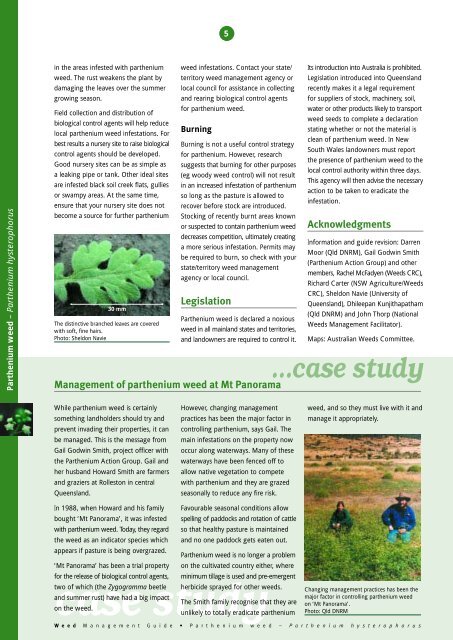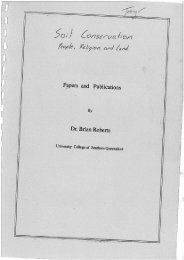Parthenium weed (Parthenium hysterophorus) - South West NRM
Parthenium weed (Parthenium hysterophorus) - South West NRM
Parthenium weed (Parthenium hysterophorus) - South West NRM
You also want an ePaper? Increase the reach of your titles
YUMPU automatically turns print PDFs into web optimized ePapers that Google loves.
5<br />
<strong>Parthenium</strong> <strong>weed</strong> – <strong>Parthenium</strong> <strong>hysterophorus</strong><br />
in the areas infested with parthenium<br />
<strong>weed</strong>. The rust weakens the plant by<br />
damaging the leaves over the summer<br />
growing season.<br />
Field collection and distribution of<br />
biological control agents will help reduce<br />
local parthenium <strong>weed</strong> infestations. For<br />
best results a nursery site to raise biological<br />
control agents should be developed.<br />
Good nursery sites can be as simple as<br />
a leaking pipe or tank. Other ideal sites<br />
are infested black soil creek flats, gullies<br />
or swampy areas. At the same time,<br />
ensure that your nursery site does not<br />
become a source for further parthenium<br />
30 mm<br />
The distinctive branched leaves are covered<br />
with soft, fine hairs.<br />
Photo: Sheldon Navie<br />
<strong>weed</strong> infestations. Contact your state/<br />
territory <strong>weed</strong> management agency or<br />
local council for assistance in collecting<br />
and rearing biological control agents<br />
for parthenium <strong>weed</strong>.<br />
Burning<br />
Burning is not a useful control strategy<br />
for parthenium. However, research<br />
suggests that burning for other purposes<br />
(eg woody <strong>weed</strong> control) will not result<br />
in an increased infestation of parthenium<br />
so long as the pasture is allowed to<br />
recover before stock are introduced.<br />
Stocking of recently burnt areas known<br />
or suspected to contain parthenium <strong>weed</strong><br />
decreases competition, ultimately creating<br />
a more serious infestation. Permits may<br />
be required to burn, so check with your<br />
state/territory <strong>weed</strong> management<br />
agency or local council.<br />
Legislation<br />
<strong>Parthenium</strong> <strong>weed</strong> is declared a noxious<br />
<strong>weed</strong> in all mainland states and territories,<br />
and landowners are required to control it.<br />
Its introduction into Australia is prohibited.<br />
Legislation introduced into Queensland<br />
recently makes it a legal requirement<br />
for suppliers of stock, machinery, soil,<br />
water or other products likely to transport<br />
<strong>weed</strong> seeds to complete a declaration<br />
stating whether or not the material is<br />
clean of parthenium <strong>weed</strong>. In New<br />
<strong>South</strong> Wales landowners must report<br />
the presence of parthenium <strong>weed</strong> to the<br />
local control authority within three days.<br />
This agency will then advise the necessary<br />
action to be taken to eradicate the<br />
infestation.<br />
Acknowledgments<br />
Information and guide revision: Darren<br />
Moor (Qld D<strong>NRM</strong>), Gail Godwin Smith<br />
(<strong>Parthenium</strong> Action Group) and other<br />
members, Rachel McFadyen (Weeds CRC),<br />
Richard Carter (NSW Agriculture/Weeds<br />
CRC), Sheldon Navie (University of<br />
Queensland), Dhileepan Kunjithapatham<br />
(Qld D<strong>NRM</strong>) and John Thorp (National<br />
Weeds Management Facilitator).<br />
Maps: Australian Weeds Committee.<br />
...case study<br />
Management of parthenium <strong>weed</strong> at Mt Panorama<br />
While parthenium <strong>weed</strong> is certainly<br />
something landholders should try and<br />
prevent invading their properties, it can<br />
be managed. This is the message from<br />
Gail Godwin Smith, project officer with<br />
the <strong>Parthenium</strong> Action Group. Gail and<br />
her husband Howard Smith are farmers<br />
and graziers at Rolleston in central<br />
Queensland.<br />
However, changing management<br />
practices has been the major factor in<br />
controlling parthenium, says Gail. The<br />
main infestations on the property now<br />
occur along waterways. Many of these<br />
waterways have been fenced off to<br />
allow native vegetation to compete<br />
with parthenium and they are grazed<br />
seasonally to reduce any fire risk.<br />
<strong>weed</strong>, and so they must live with it and<br />
manage it appropriately.<br />
In 1988, when Howard and his family Favourable seasonal conditions allow<br />
bought ‘Mt Panorama’, it was infested spelling of paddocks and rotation of cattle<br />
with parthenium <strong>weed</strong>. Today, they regard so that healthy pasture is maintained<br />
the <strong>weed</strong> as an indicator species which and no one paddock gets eaten out.<br />
appears if pasture is being overgrazed.<br />
<strong>Parthenium</strong> <strong>weed</strong> is no longer a problem<br />
‘Mt Panorama’ has been a trial property on the cultivated country either, where<br />
for the release of biological control agents,<br />
case study<br />
two of which (the Zygogramma beetle<br />
and summer rust) have had a big impact<br />
on the <strong>weed</strong>.<br />
minimum tillage is used and pre-emergent<br />
herbicide sprayed for other <strong>weed</strong>s.<br />
The Smith family recognise that they are<br />
unlikely to totally eradicate parthenium<br />
Changing management practices has been the<br />
major factor in controlling parthenium <strong>weed</strong><br />
on ‘Mt Panorama’.<br />
Photo: Qld D<strong>NRM</strong><br />
W e e d M a n a g e m e n t<br />
G u i d e • P a r t h e n i u m w e e d – P a r t h e n i u m h y s t e r o p h o r u s

















